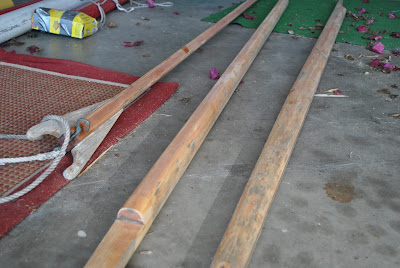Since breaking the boom on Training Wheels, I have heard from quite a few sailors that have done the same thing!
I had read about it in books like “Dove”, the circumnavigation of sixteen year old Lee Grahm in the 50's. Back in those days they had no satellite phone and no SSB (Short Side Band radio) to call the Coast Guard or Local Harbor Assist. They had to make do with what they had.
I have mentioned a few times before, I want to learn the sailing craft on Training Wheels the old-school way before I learn with modern conveniences. After the boom breaks, I am sure the first thing many will do is let out a four letter explicative or two. The first constructive thing to do is to turn into the wind to relieve the pressure off the sails. Next, take down the sail.
Before you rig a make-shift boom you need to have the mainsail under control on deck. This sounds easy, but it was really hard for me to do that day on Training Wheels. The first thing I did when the boom broke was to furl the Genoa. Looking back this was probably a mistake We had rounded Point Buchon and were about a mile from shore. At this close a distance to land the shallow water caused the swell to have risen to about 6 feet at a fairly close interval. The swell and the wind made it impossible for me to turn the boat into the wind with just the flapping main sail that I could no longer control. Even after turning on the engine I could still not get the boat point into the wind. I believe keeping the Genoa up would have helped this.
I had read about it in books like “Dove”, the circumnavigation of sixteen year old Lee Grahm in the 50's. Back in those days they had no satellite phone and no SSB (Short Side Band radio) to call the Coast Guard or Local Harbor Assist. They had to make do with what they had.
I have mentioned a few times before, I want to learn the sailing craft on Training Wheels the old-school way before I learn with modern conveniences. After the boom breaks, I am sure the first thing many will do is let out a four letter explicative or two. The first constructive thing to do is to turn into the wind to relieve the pressure off the sails. Next, take down the sail.
Before you rig a make-shift boom you need to have the mainsail under control on deck. This sounds easy, but it was really hard for me to do that day on Training Wheels. The first thing I did when the boom broke was to furl the Genoa. Looking back this was probably a mistake We had rounded Point Buchon and were about a mile from shore. At this close a distance to land the shallow water caused the swell to have risen to about 6 feet at a fairly close interval. The swell and the wind made it impossible for me to turn the boat into the wind with just the flapping main sail that I could no longer control. Even after turning on the engine I could still not get the boat point into the wind. I believe keeping the Genoa up would have helped this.
After you are able to the sail under control you can sail under Genoa alone, but this can cause control difficultly on some points of sail. Plus that ends the discussion and makes for a boring blog. So then we move on to creating a new boom. Creativity is key but needs to be paired with a good amount of compromise. The new boom does not need to be as long or as strong as the original. You only need something that will fit the main sail reefed down as far as possible. On training wheels this would cut the original boom length of 12 feet to 8 feet.
The standard replacement for a boom is to use a whisker pole. It is usually about the right size for a reefed main and has enough strength the the job. Depending on the attachment type of the whisker pole you may need to use a piece of line to secure the whisker pole to the mast and act as a down haul (line holding boom down near the mast) to keep the pole from lifting during gusts. The main sheets can be tied directly to the main sail clew (bottom back or aft corner of the sail) or on the whisker pole. Another option often may be to use a remaining piece of the boom or anything you have that is close to being long enough.
The standard replacement for a boom is to use a whisker pole. It is usually about the right size for a reefed main and has enough strength the the job. Depending on the attachment type of the whisker pole you may need to use a piece of line to secure the whisker pole to the mast and act as a down haul (line holding boom down near the mast) to keep the pole from lifting during gusts. The main sheets can be tied directly to the main sail clew (bottom back or aft corner of the sail) or on the whisker pole. Another option often may be to use a remaining piece of the boom or anything you have that is close to being long enough.









